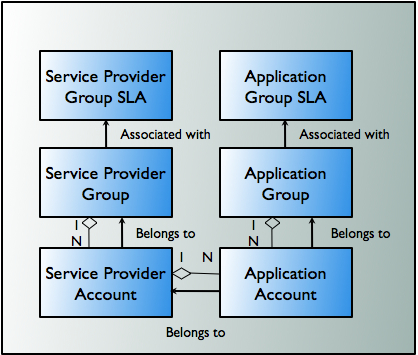29 Managing Legacy Application Service Providers
This chapter explains the Oracle Communications Services Gatekeeper framework for managing service providers and applications that was used before the partner relationship manager (PRM) portals were created.
This functionality is an alternative to using the PRM portals to create partners, partner groups, and network service suppliers (NSSs). This chapter has the same concepts but a different nomenclature. It explains how to manage the service providers and service provider groups that perform many of the same functions as partners and partner groups.
WARNING:
Use either the PRM portals to create these entities, or the instructions in this chapter, but do not attempt to mix them.
About the Management Framework
Services Gatekeeper provides a partner administration model that you can use to manage your partner relationships. Application service providers are registered with Services Gatekeeper through service provider accounts and application accounts. Each account type is associated with a group. Each group is associated with an SLA that defines its access to both Services Gatekeeper and underlying network nodes.
You can register service providers in the following ways:
-
Using the Services Gatekeeper Administration Console graphical user interface.
-
Using an external management system, integrated with Services Gatekeeper using the partner relationship management graphical user interface.
-
Using an external management system integrated with Services Gatekeeper using JMX.
The Administration Model
The Services Gatekeeper administration model enables you to control application-service-provider access at various levels. An application service provider registers with Services Gatekeeper and is given a service provider account. To support tiering, you assign service provider accounts to account groups. You then associate these account groups with their own service provider group SLAs.
Individual application accounts are registered within a service provider account. These application accounts also belong to account groups, each of which is associated with its own account group SLA.
Service provider group and account group SLAs regulate, for example, the type of service capability made available and the maximum bandwidth use allowed. SLAs may also specify access to charging capabilities and revenue sharing schema. Services Gatekeeper provides standard versions of service provider group and application group SLAs, and custom SLAs of both types.
Figure 29-1 illustrates the relationship between accounts, groups, and their SLAs.
Figure 29-1 Service Provider and Application Administration Model

Description of ''Figure 29-1 Service Provider and Application Administration Model''
Using the Platform Development Studio, you can extend this model to include users as well. For more information, see Services Gatekeeper Extension Developer's Guide.
In addition to the service provider group and account group SLAs, Services Gatekeeper provides two types of traffic SLAs: service provider node SLAs and global node SLAs. You can also create global node custom SLAs. These are contracts designed to protect the underlying telecom network. Service provider node SLAs regulate the relationship between a service provider group and the network nodes to which it has access.
Figure 29-2 illustrates the relationship between service provider groups and network nodes, based on the service provider node SLAs.
Figure 29-2 Service Provider Traffic SLAs

Description of ''Figure 29-2 Service Provider Traffic SLAs''
In Figure 29-2, service providers in service provider group 1 are allowed to access all network nodes because their service provider node SLA (valid for all service providers within the group) contains node contracts for all nodes.
Service providers in service provider group 2 are allowed to access only network nodes 1 and 3 because their service provider node SLA contains contracts only for nodes 1 and 3.
The second type of traffic SLA, the Global Node SLA, regulates the overall relationship between Services Gatekeeper and the underlying nodes.
Partner Relationship Management Interfaces
You use the Services Gatekeeper partner relationship management interfaces to automate tasks related to service provider and application administration. These interfaces support request and approval workflow for helping service providers set up their service provider and application accounts. The interfaces also enable service providers to communicate account change requests, and to retrieve usage statistics for their accounts.
For a detailed description of the partner relationship management interfaces, see Services Gatekeeper Portal Developer's Guide.
Note:
For an application to use Audio Call-based services, announcements must be recorded and installed in the network.